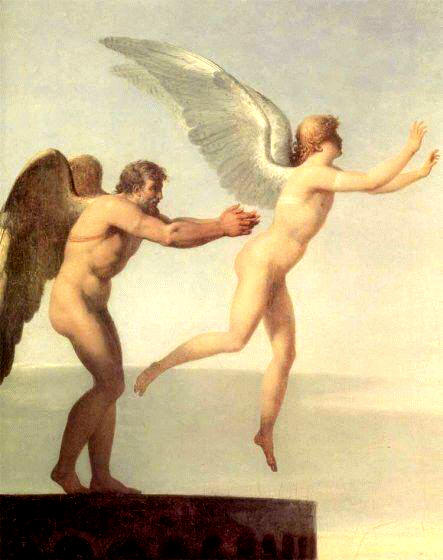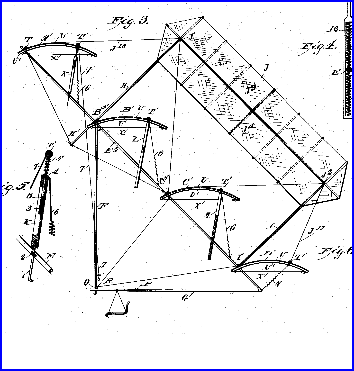|
1900 1901 1902
1903 1904 1905
1906 1907 1908
1909
1910
1911 1912 1913
1914 1915 1916
1917 1918 1919
1920
1921 1922 1923 1924
1925 1926 1927
1928
1929
1930 1931 1932
1933 1934 1935
1936 1937 1938
1939
Hang Glider History
Timeline
EnterData +
Send your favorite timed item to
timeline@hanggliderhistory.com
Notes: Link prefix with "g" is a generalized Google search.
Prefix with a "w" is a leading Wikipedia file on topic. |
Books and Art |
 
CHARLES H. LAMSON
Kites, gliders, hang gliders, aeroplanes would have option of having two,
three, or more surfaces for flying purposes. Propulsion could be by
the pull of gravity of a hanging pilot. |
1900 |
| Complex:
Wrights "hang" from upper wing, but don't hang on the lower wing of biplane
aircraft. This hybrid aircraft is partly hang glider and partly non-hang
glider. An aim toward powered flight brings on a complex.
|
???
[_top_] |

KITE
OR
FLYING MACHINE
VICTOR
TARCZAL
Just hang the hang glider pilot at the right hang point to
get the glider flying machine.
Patent number: 701644
Filing date: May 13, 1901 |
1901 |
Let there be metal and ribs of metal and still
foldability...
Patent number: 724402 Filing date:
Jul 5, 1902

METAL KITE-FRAME JOHN H. STEIN |
1902
|
|
|
1903
|
|
|
1904

|
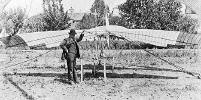 
AEROPLANE John J. Montgomery
U. S. Patent number:
831173
Filing date: Apr 26, 1905
[ The "G" device is for feet to control things;
do not confuse "G" with a
buttock seat.]

- Carl Bates
learned powered-plane flying skills. He built more glider this year and next.
|
1905 |
|
EnterData
|
1906
EnterData+
[_top_]
|
|
|
1907 |
|
|
1908
W. Simon |
|
|
1909 |
-

FLYING MACHINE Lee et al.
U. S. Patent number: 989786
Filing date: Feb 15, 1910
Issue date: Apr 1911
Inventor: Lee et al.
- Pre-Wanner
- Pre-NASA
- Pre-Paresev 1B
- Pre-Palmer
- Pre-Ryan
- Pre-Burns
- Pre-Dickenson
- Pre-Moyes
-
Pre-Bennett
-
Pre-Rogallo
-
-
-
Weight shift coupled with wing ailerons: See article on
letter to the editor.
-
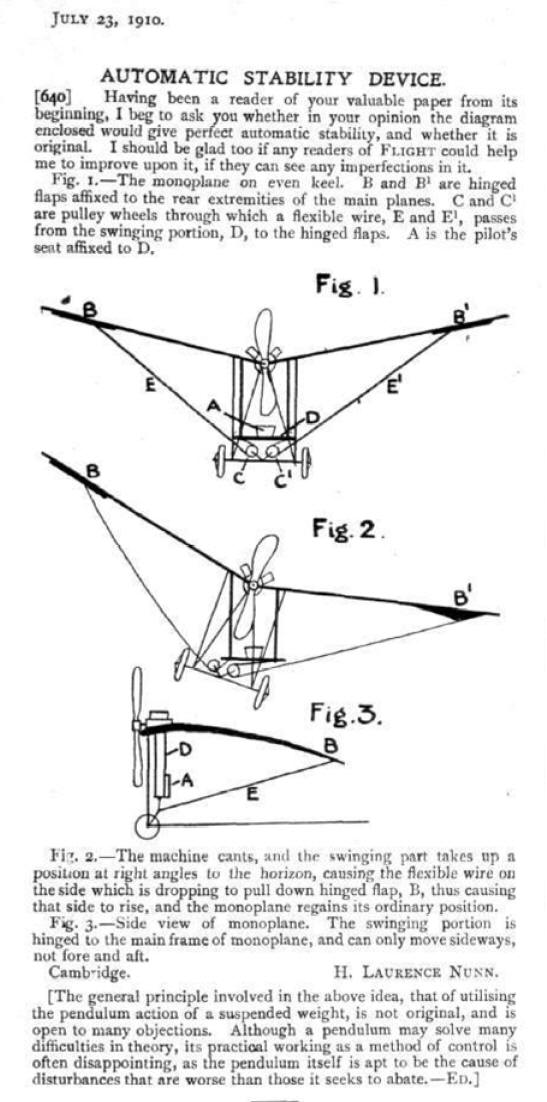
Often, but not always, as users proved in their hang gliding flights and even
powered flights of that decade.
-
-
- Building up the aviation bag of tricks
possibly useful for any designer: Warrick offers:
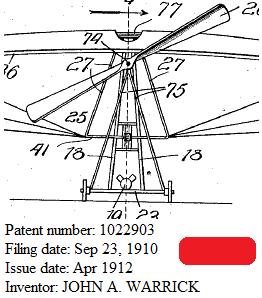
FLYING MACHINE
US Pat. 1022903 - Filed Sep 23, 1910
FLYING MA.CHINE. ... MACHINE ...
Brace the triangle down tubes and base bar with cables.
Have another triangle with wheels on it for landing.
Decide to drop the propeller. Let the pilot be hung
below acting as a gravity engine.
Notice two uses of the 19th Century Pratt truss; we will
see wheels on a hang glider triangle control bar stayed with cables having the
vertical members in compression.
- Gyroplane
Patent number: 1040136 Filing date:
Aug 3, 1911
Issue date: Oct 1912 Inventor: Brown
-

SAFETY ALIGHTING ATTACHMENT
FOR FLYING MACHINES
-
-
JEAN FRANCIS WEBB
Presaging rescue parachutes for hang gliders.
|
1910
EnterData+
[_top_]
|
- San Francisco Chronicle 1911 Feb 23
Drawing of strutted triangle control bar in a biplane hang glider; female pilot
sitting on a sling. (Ken de Russy collection)
-
1911 glider flight by Wright brother.
Tensional from upper wing, but compressional on lower wing: thus, this is a
"hybrid" hang glider with controls.
-

FLYING-MACHINE ALFRED THEODOR ZEISE Flying machine
---human-powered hang glider:
Patent number: 1052199
Filing date: Dec 1, 1911
Issue date: Apr 1913
Inventor: ALFRED
THEODOR ZEISE
-
AEROPLANE
Dorsette A. Davison, (Online has spelling error 'Davidson' while the
patent has the correct spelling of "Davison". Also, the online filing has "Aesoplane"
but the patent has "Aeroplane")
filed December 14,
1911:
U. S. Patent 1,038, 306

AERODROME JAMES TRAVIS
U. S. Patent number: 997521 Filing date: Mar 7,
1911
[How much will human power play in the coming history of hang gliding?
Ornithoptering and pedaling to propellers....and storage of human power...???] |
1911
EnterData+
[_top_]
|
|
|
1912
EnterData+
[_top_]
|
|
|
1913
EnterData+
[_top_]
|
- June 25, 1914, L'Aero journal notes on an airplane that uses
a wing control that interests us. Louis de Monge modified a "De Perdussin"
airplane. What does this have to do with hang gliding?
-
|
1914
EnterData+
[_top_]
|
 The
descriptions in a patent are often more important than the limiting drawings;
claims can be very extensive. In the following patent, some hang glider
designers (free-flight dynamic free-falling anchor--the hang glider pilot--
kites ) may derive important insights for foldability of the whole of a hang
glider or a part of a hang glider by studying a patent. Marcus P. Exline
indicates some novel means to have a foldable wing.
M. P. EXLINE U. S. Patent:
1166750 Filing date: Apr
9, 1915 The
descriptions in a patent are often more important than the limiting drawings;
claims can be very extensive. In the following patent, some hang glider
designers (free-flight dynamic free-falling anchor--the hang glider pilot--
kites ) may derive important insights for foldability of the whole of a hang
glider or a part of a hang glider by studying a patent. Marcus P. Exline
indicates some novel means to have a foldable wing.
M. P. EXLINE U. S. Patent:
1166750 Filing date: Apr
9, 1915
|
1915
EnterData+
[_top_]
|
 Perhaps
building upon Hargrave's success and Bell's tets, etc., Lang prepares further
foundations for the eventual Jalbert discoveries for paragliding and other
aircraft systems: Perhaps
building upon Hargrave's success and Bell's tets, etc., Lang prepares further
foundations for the eventual Jalbert discoveries for paragliding and other
aircraft systems:
ANDREW LANG GRAHAM or A. L. GRAHAM
U. S. Patent number:
1223163 Filing date: Dec 14,
1916
|
1916
EnterData+
[_top_]
|
| |
1917
EnterData+
[_top_]
|
| |
1918
EnterData+
[_top_]
|
-
 Toy
gliders guide human minds. The airplanes and glider of Germany and U.S. keep
gliders on the market for children. Aeromodelling will continue to grow and
prepare the world for increased use of gliders. Toy stores would never again be
without toy gliders for youth. Toy
gliders guide human minds. The airplanes and glider of Germany and U.S. keep
gliders on the market for children. Aeromodelling will continue to grow and
prepare the world for increased use of gliders. Toy stores would never again be
without toy gliders for youth.
TOY AEROPLANE OB GLIDER
MATHEW B. MCINNIS
U. S. Patent number: 1400224
Filing date: Nov 7, 1919
-
-
28 June 1919
Treaty of Versailles
was signed. Effects on sport gliding in Germany would be important to the
history of hang gliding sport.
Discuss HERE.
-
|
1919
EnterData+
[_top_]
|
-
Popular Science cover featured artwork
of a tri-plane hang glider. The article title: " 'Glider' Coasting Is Newest
Outdoor Sport" (Page 21). So, sport of hang gliding
continues its modern growth.
-
Gyrocopter (toward gyro hang glider?)
See gyroplane 1911.
http://www.google.com/patents?id=JBc_AAAAEBAJ&dq
Patent number: 1361222
Filing date: Jan 23, 1920
Issue date: Dec 7, 1920
Inventor: EMILE BERLINER
Assignee: GYRO
|
1920
circa
EnterData+
[_top_]
|
Gottlob Espenlaub's first hang gliding
competition at Wasserkuppe, Germany, 1921.gGE1
..study as he deposits key control frame art for anyone to use..., even his
hang glider's "A-frame" strutted, or based-W frame. Or cabled with kingpost or
cantilevered---ways well worn in aviation already!

 wiki:
wiki: |
1921
EnterData+
[_top_]
|
-
Gottlob Espenlaub 1922 delta hang
glider:
[wiki10]. During the Wasserkuppe 1921 hang gliding competition, he met
Alexander Lippisch and both begun a collaboration on drafts and models of
gliders and hanging gliders.
-

A. B. WILDER
U. S. Patent 1,490,356
Filing date: Dec 21, 1922
|
1922
EnterData+
[_top_] |
|
|
1923 |
-
Born: Donald K. Slayton ...destined to be a Paresev hanging glider
pilot.
Born March 1, 1924. See the Paresev
flight log (incomplete, but as complete as the the NASA history dept.
can give to date). He was one of eight pioneering test pilots who flew the
framed Rogallo wing designed by Charles Richard, which wing became a template
for a class og hang gliders called the Standard Rogallo--which class was fed by
many avenues of design flow around the world.
|
1924 |
-
Born: Dr. Paul MacCready
took the Next Thermal. Helios. Solar Challenger.
Centurion
ssaCentpc1 Paul B. MacCready,
Jr. (September 25, 1925 - August 28, 2007)
wPMcC1
|
1925 |
| |
1926 |
-
Domina Jalbert receives pilot's license
(626th to have
such in USA) . He is destined to serve in war with huge dirigible kytoons
and then shake the universe with ram-air airfoils to found the wing to be most
popular for modern paragliding (in the sense of the term of 2007).
-


FOLDING KITE
Patent number: 1690362
Filing date: Apr 27, 1927
FOLDING KITE
CLARENCE NEIL DE WITT
|
1927
Foldability of Rogallo-wing-using kites and
gliders are very much thought about and solved prior to 1927 and after 1927,
even before they realized that a Rogallo wing lived embedded in the framings!
EnterData+
[_top_]
|
| |
1928 |
![Dr. George A. Spratt towed his single hang point glider on floats using a motorboat. 1929. [98][99]](http://upload.wikimedia.org/wikipedia/commons/thumb/f/f3/EarlySpratt6.jpg/180px-EarlySpratt6.jpg) Dr.
George A. Spratt towed his single-hang-point glider on floats using a
motorboat. 1929.
[wiki 98][wiki
99] Dr.
George A. Spratt towed his single-hang-point glider on floats using a
motorboat. 1929.
[wiki 98][wiki
99]
 wiki
But notice that the triangle control bar is set to be part of the hang glider's
wing control. The pilot/fuselage is freely hanging from the airframe; recall
your first lesson in hang gliding where you let go of the airframe and let the
wing/airframe fly in trim==you were meeting the legacy of George Spratt at that
moment. wiki
But notice that the triangle control bar is set to be part of the hang glider's
wing control. The pilot/fuselage is freely hanging from the airframe; recall
your first lesson in hang gliding where you let go of the airframe and let the
wing/airframe fly in trim==you were meeting the legacy of George Spratt at that
moment.
Read a Spratt patent ==>
U.S.
Patent 2623712 (click the first one on top, but explore
the others as you have time and interest).
-
Notice that the triangle control
frame is integrated firmly as part of the airframe with wing.
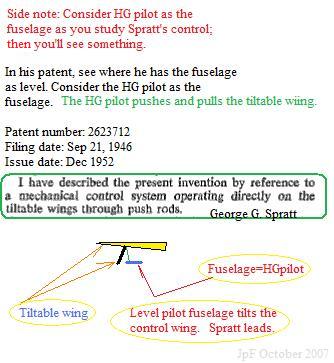
-
Notice that the fuselage
is actually the combined masses of pilot, seat, tensional member that is
pivoted and which is a holder of the pilot (think of harness and hang
line which could even be stiffened as in Paresev 1B).
-
Notice that the pilot (part of fuselage) is
tensionally hanging while being freely pivoting from a hang point during
flight.
As the pilot--with all his other parts of his
fuselage--initiates a push or pull fore or aft or left or right, then the
relative attitude of the controlled wing with respect to the pendulumed
fuselage results in a method of control for gliders, aircraft, kites, and hang
gliders. This inventive gift forms a basis for the Paresev 1B hang glider, the
SkiPlane, and modern hang gliders using the airframed triangle or U or based-W
control parts. The fuselage is the pilot and the chosen payload (clothes, etc)
hung tensionally leaving the control wing to rotate as needed for controlling
flight by the hang glider pilot. Having this gift from Spratt or those before
him, perhaps Gottlob Espenlaub and others, prevents others from being
valid global invention claimants of the control system for aircraft and hang
gliders. Look to Chanute for some feed toward the Spratt leadership.
Click==>
EnterData for that Chanute feed...+
-
Henri Mignet, Pou de Ciel, "Flying
Flea" . Tests on HM2, HM 6, and HM9 : "pivoting wings".
What does this have to do with hang gliding?
|
1929
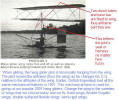
EnterData+
[_top_]
|
| |
1930
EnterData+
[_top_]
|
| |
1931
EnterData+
[_top_]
|
|
|
1932
EnterData+
[_top_]
|
| HPA: "1933/5
Haessler & Villinger design MUFLI using external bracing for 5.5m wing. 1.5
prop with belt drive. Empty weight 34kg. Best flight 235m on 30.8.1935. Flights
launched by tensioned cable, contained within nose. Later flights 427m on
17/11/1936 and 712m 4/7/1937 OVER 120 flights."
http://ourworld.compuserve.com/homepages/j_d_mcintyre/dates.htm See more
there.
w:HV-1 Mufli [ ]
Did any in Mufli crew hang glide? |
1933
EnterData+
[_top_]
|
-
Dr. George A. Spratt died on November 24, 1934, from a heart attack;
he had stopped his medical practice because of a heart ailment about 1895 or
1896 and began to dvote himself full time to the problem of human flight--about
a 40-year reprieve doing something he loved doing about flying! His
son George G. Spratt would continue in some controlwing works.
Modern hang gliding uses the Chanute and Spratt controlwing technology
as we lever the attitude of the wing even though we call it weight-shifting, we
are generally the stable point pushing and pulling on the wing directly through
the control frame.
|
1934
EnterData+
[_top_]
|
 
GLIDER Sohn
et al.
Patent number: 2067423
Filing date: Nov 7, 1935
Issue date: Jan 1937
|
1935
EnterData+
[_top_]
|
| "Helica" ,
Marcel Leyat constructs.... but Andre Jacquemin (mfg and
pilot). Pivoting wings. |
1936
EnterData+
[_top_]
|
| |
1937
EnterData+
[_top_]
|
| Bob Morse
(clipping from Ken de Russy collection) "Flies 2,000 Feet In Hang-Type Glider
Flying a home-built hang-glider of his own design, Bob Morese, of Los Angeles,
Calif., claims to have made a flight of 2,000 feet during which the glider
attained a heigh of more than 100 feet. The novel glider's frame is
mounted on a single wheel and launching is accomplished by running downhill
against the wind. Morse pilots his glider by movements of his body, to
which the various flight control cables are strapped. " |
1938
EnterData+
[_top_] |
| |
1939
EnterData+
[_top_]
|

![Dr. George A. Spratt towed his single hang point glider on floats using a motorboat. 1929. [98][99]](http://upload.wikimedia.org/wikipedia/commons/thumb/f/f3/EarlySpratt6.jpg/180px-EarlySpratt6.jpg) Dr.
George A. Spratt towed his single-hang-point glider on floats using a
motorboat. 1929.
[wiki 98][wiki
99]
Dr.
George A. Spratt towed his single-hang-point glider on floats using a
motorboat. 1929.
[wiki 98][wiki
99]
